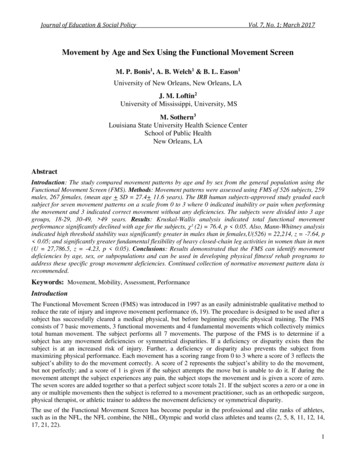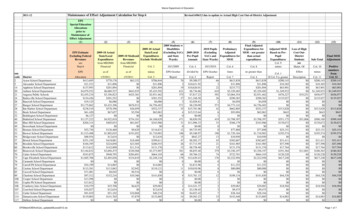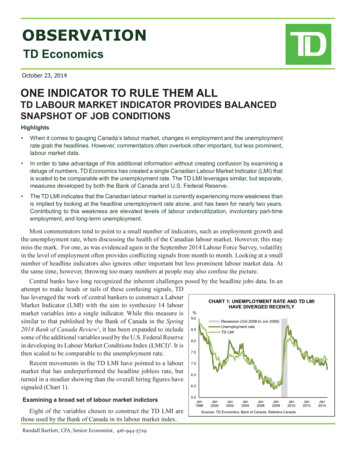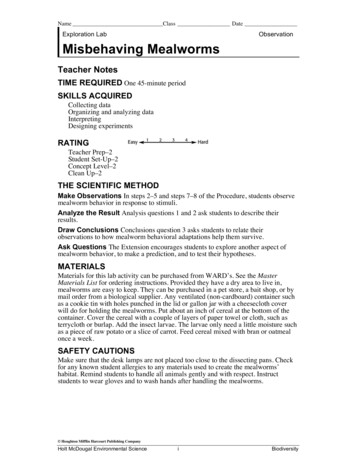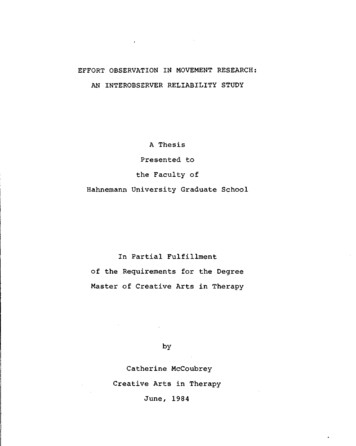
Transcription
EFFORT OBSERVATION IN MOVEMENT RESEARCH:AN INTEROBSERVER RELIABILITY STUDYA ThesisPresented tothe Faculty ofHahnemann University Graduate SchoolIn Partial Fulfillmentof the Requirements for the DegreeMaster of Creative Arts in TherapybyCatherine McCoubreyCreative Arts in TherapyJune, 1984
ABSTRACTEffort observation describes the qualitative process ofhuman movement in terms of the mover's inner attitudestoward using flow, space, weight, and time. Althoughit has been applied usefully to the study of body movementin dance and theater performance, child development, psychotherapy, and culture, Effort observation cannot be incorporated into formal research methodology until itdemonstrates reliability as a measuring instrument.An interobserver reliability study of Effort observationwas administered to test the hypothesis that statisticallysignificant interobserver reliability can be obtained amongindependent ratings of Effort elements and qualities. Aninterclass correlation coefficient was computed for eachpair of Effort qualities, (e.g., Strength and Lightness),to determine the consistency of raters by Effort element,(e.g., Weight). To establish reliability scores for eachquality, (e.g., presence or absence of Strength), aChi square was calculated. A nonsignificant Chi squarewas expected to indicate consistency. Observations ofSpace, Weight, Time, Bound Flow, Directness, Strength,Lightness, and Suddeness achieved a respectable degreeof statistically significant interrater consistency.Observations of Flow, Free Flow, Indirectness, and Sustainment did not. These findings imply (a) the need to reformulate the concept of Flow; (b) the presence of culturalbias in the observation of "indulging" attitudes towardSpace and Time; and (c) the need for more interobserverreliability tests of Effort observation.iii
Where are we right now?.The beginnings of organizing movements into sequence is really one of thevery basic concepts through Laban material; that it's ordered itself into spatialenergy and flow patterns is at the essence.I'm mulling over these things, and I feelthat an adequate anatomical concept thatconsiders all the neurological factorswill feed into this and some of the phenomenological concepts or perceptual research. all of these things should becomeintegrated. We don't have to break thewhole Laban thing apart. We don't haveto prove every section, but each can bevalidated as part of the holistic conceptof movement.Irmgard Bartenieff(Siegel, 1980, p. 16)May all my work show the way to joy.Rudolf Labaniv
DEDICATIONTo the LIMS community.v
ACKNOWLEDGMENTSI'd like to acknowledge my debt to the students ofMovement Observation in the Hahnemann movement therapyclasses of 1983, '84, and '85 for helping me learn howto teach them Effort. Many hours of thesis researchtranspired through their frustrations and discoveries.For their pioneering contributions in movement research and their cooperation in this project, I expressmy appreciation to Martha Davis, Deborah Du Nann, BethKalish, Vera Maletic, Marion North, Pamela Ramsden, andK. Mark Sossin.To those who pushed and pulled and lent support,my utter gratitude; Ann Amromovage, Brenda Byrne, CaroleCrewdson, Joan Fisher, Nicole Fisher, Theresa Fleury,Myra Levick, Gary Lord, Barbara Nussbaum, Hal Rubin,Emily Samuelson, William ter Marsch, and Jody Zacharias.I also want to thank the extraordinary teachers whohave always been there to mind the soil; Mme. VeraVladimiroff, Maru Sadek, Abram Engelman, Irmgard Bartenieff,Virginia Reed, and Dianne Dulicai. I hereby offer evidencethat their faith has taken root.vi
CONTENTSLIST OF TABLESviiiINTRODUCTION1LITERATURE REVIEW5History of Laban Movement Analysis. . . .Perceptual Issues in Effort Observation.5.Descriptive Methods in Social Research . . .Effort Observation in Movement RY AND CONCLUSION58REFERENCES62APPENDIX67vii
LIST OF TABLESTable 1DATA COLLECTION AND RELIABILITY37Table 2BACKGROUNDS OF RATERS47Table 3INTERRATER RELIABILITY OF EFFORT ELEMENTS. . .50Table 4INTERRATER RELIABILITY OF EFFORT QUALITIES . . .51viii
INTRODUCTIONFrom cave painting to literature and photography, waysof perceiving humankind and its activities have been shapedby the self-knowledge, world view, and media of expressionparticular to each cultural period. Today the developmentof film and video technology affords us an unprecedentedopportunity to study body movement and nonverbal behavior asdynamic processes. We are confronted with a new perceptionof ourselves in motion and a wealth of data requiring newmethods of analysis that could yield fresh insight into thefunctional and expressive meanings of our behavior.From prenatal stirrings until death, movement evincesqualities of thinking, feeling, and acting which we identifyas behavior. Movement notation systems devised to recorddance can also be used to describe behavioral processes(Davis, 1977). "Movement is a medium with its own charateristics," and Laban Movement Analysis offers "descriptionsof movement in its own terms" (Davis, 1974, p.l).Just as study of visual perception engendered new concepts about the nature ofcognition, attention to the movement dimension can give birth to radical ideasabout personality, group dynamics, thenature of emotion, and social role behavior. But in order for this to happen,movement must be permitted to "speak foritself": descriptive terms, metaphorsand criteria from other disciplines shouldnot simply be imposed upon it. (p.2)But in order to allow movement behavior to speak for itself,the terms of Laban Movement Analysis (LMA) must demonstratereliability and validity as research parameters. This thesis will address the utility of Effort observation, the as-
2pect of LMA that describes the dynamic qualities of movement.Effort observation is the recognition of the inner attitudes with which people move in relation to the motion factors of space, weight, time, and flow as they exert energy tocope with somatic and intrapsychic dynamics, interpersonalprocesses, and cultural influences on behavior. RudolfLaban, a choreographer and movement theorist from CentralEurope, developed the concept of Effort within a broad framework of movement analysis and notation from the 1920sthrough the '50s. The original German work that he used toidentify these inner attitudes, later translated as "Effort",was "antrieb, a combination of an [on] and trieb [drive],representing the organism's urge to make itself known"(Bartenieff and Lewis, 1980, p. 51) .This philosophical definition gains clarity from anunderstanding of how Effort works. When a body part movesthrough space, the resulting gesture is motivated and enlivened by the mover's experience of and response to everchanging states of tension; physical, cognitive, and affective. The gesture is colored by the particular qualities ofintention that "drive" it along its path of fluctuating combined tensions. Rather that a Newtonian perception of motion factors, the Effort elements of Space, Weight, Time,and Flow reveal the mover's subjective attitude toward them.Each element occurs somewhere along a continuum between opposite qualities. Alternations between the qualities of FreeFlow, the ongoingness and fluidity of movement, and BoundFlow, the restriction or holding back of movement, provide akind of baseline for the changing current of dynamic events.Toward Space, a movement might demonstrate Directness, a narrow channeled attention, or Indirectness, a multifocussedencompassing awareness. Toward Weight, an attitude ofStrength, a quality of assertiveness against gravity, mightbe used, or Lightness, a quality of overcoming gravity.
3Toward Time, a sense of urgency or Suddenness rather thanspeed, or Sustainment, a sense of prolonging rather thatslowing down time, might impel the movement.During the progression of a movement phrase, these qualities appear in combinations whose sequence is organized byboth functional and expressive purposes, conscious and unconscious. By identifying the characteristic phrases of themover's repertoire, describing the patterns of momentarychanges within these phrases, and studying the relationshipsbetween the use of Effort and how the body moves throughspace, the observer develops a picture of how the mover organizes behavior. Effort observation allows the observer toperceive with great sensitivity the mover's qualitative experience or transformation in the act of modulating all thetensions to which the mover is sentient.The unique value of this tool lies in its ability to describe movement process rather than isolated moments of static positions. The clinician or researcher concerned with aspecific sequence of behavior, its functions and meanings,can discern the play of forces that orders the course of actions by analysing the movement components. Within thestructure of Laban Movement Analysis, these details form interrelated patterns of variously organized change which aresignificant for their behavioral consequence. Although movement findings are often correlated with psychological profiles, movement analysis is not simply an equivalent topsychological evaluation, A movement assessment is based onthe observation ofothe smallest visible events that make upbehavior, rather than the traditional units of behavioral research which are either microscopic or gross by comparison.References to current developments in observational research methods, however, emphasize advanced mechanical techniques to record behavior (Helmstadter, 1970), rather than aneed to refine our perceptual skills or to learn how to
4apply them. Laban movement studies have already begun toilluminate the understanding of body movement in dance andtheater performance, child development, psychotherapy, andculture, but there is little data to substantiate Effortobservation as a legitimate tool for the behavioral sciences.A systematic observer reliability study of LMA including theproduction of an observation training videotape of movementsexemplifying terms, a corresponding compendium, and a seriesof controlled reliability tests using rigorous observeragreement criteria is in progress at the Laban Institute ofMovement Studies in New York under the direction of MarthaDavis who designed the study. This thesis will test the hypothesis that a statistically significant degree of interrater reliability can be obtained among independent ratingsof Effort elements and qualities by trained observers.To further the understanding and use of Effort observation as a research tool for the study of human process, thefollowing Literature Review includes the development ofEffort theory and practice within Laban Movement Analysis,perceptual issues in Effort observation, descriptive methodsin social research, and a comparative study of Effort observation in movement research by Davis, 1970; Du Nann andRamsden, 1983; Kalish, 1976; Maletic, 1980; North, 1972; andSossin, 1983.
LITERATURE REVIEWThis chapter is organized into four sections. The firstpart presents the development of Effort theory and practicewithin Laban Movement Analysis. The second part examinesEffort theory and observation training in terms of perceptualprocesses which elucidate the nature of Effort and suggestapproaches to training observers that might increase interrater reliability. The third part surveys traditional observation research methods to provide a context for evaluatingEffort observation as a research tool. And the last sectionoffers a comparative study of movement research projects thatused Effort observation based on returns of a questionnairedesigned by the author.History of Laban Movement AnalysisLabanotationLaban's work as a choreographer led to his examinationof early forms of dance writing and to his own invention ofa system for notating the structure of movement. He usedsymbols to indicate body parts involved, weight shifts,timing, changes in direction and levels of space, touch,orientation, and floor patterns (Hutchinson, 1970; Knust,1979; Laban, 1975; Preston-Dunlop, 1966a, 1966b, 1967,1969).That system has been refined by years of application, theoretical discussion, and formal decisions on definitions andprocedures by the International Congress of KinetographyLaban. In the United States, this system is known asLabanotation and is primarily used to score choreography.The value of this particular notation lies in the graphiccoherence of its symbols. They communicate at once thehighly specific, simultaneous actions of a movement sequencewhich convey "the rhythms and body-spatial tensions withinthe movements" (Bartenieff & Lewis, 1980, p. 218).
6Space HarmonyLaban (1974) also became intrigued by how the actualforms of movement reflected changing spatial tensions. Bytravelling along, around, or through one, two, or threedimensions, the mover could experience the dynamic balanceof crystalline forms, order transitions between spatialstresses into movement scales, and create an infinite variety of trace forms or pathways in space. Laban emphasizedhow the play of tensions resonates through the progressionof forms and fills space with "living architecture" (p. 4)."The rules of the harmonic relations in space" between themoving body and spatial tensions were called Space Harmony.EffortRelocated in England during World War II, Laban wasasked to suggest means of increasing factory workers' productivity on assembly lines. While studying their repetitive motions, he observed how individual variations in rhythm, applied to the same job, resulted in different degreesof efficiency. Thus, Laban became more concerned with how amovement was performed—the process of its conduct—thanwith what the movement was, or whether it achieved its goal.Instead of recommending mechanical improvements in the execution of a task, he choreographed a rhythmical approach integrating the exertion and recuperation of the total body withthe dynamic qualities which were the most economic and comfortable for the workers. Laban began to speculate aboutthe nature of these qualities that revealed individual differences. In the past, he had referred to the study of thedynamics of movement as Eukinetics. The realization oftheir significance in his work analyses lent new impetus tothe conceptualization of Effort as subjective attitudes
7toward Flow, Space, Weight, and Time and their organizationinto meaningful patterns (Laban and Lawrence, 1974) .ShapeLater in this period, Warren Lamb, a student and colleague of Laban, further observed that the way both laborersand managers shaped their gestures through the three majorspatial planes seemed to indicate their preferences and aptitudes for different kinds of work (Lamb, 1965) . He alsonoted the intrinsic relationship between these spatial patterns and the Effort qualities with which they occurred.The theory of Effort/Shape (E/S) emerged from the logicaland observable affinities of the inner attitudes to shapingin the vertical, sagittal, and horizontal planes, e.g.,Rising with Lightness and Narrowing with Directness. Lambwent on to devise the Action Profile as an assessment toolfor management consultation (Ramsden, 1976; Rose, 1978).The reliability of the Profile is discussed later in thischapter (Du Nann and Ramsden, 1983) .Bartenieff FundamentalsIn the next stage of development, E/S theory incorporated a consonant body discipline that gave Laban movementthinking a corporeal foundation. Irmgard Bartenieff was adancer with a background in art and biology when she studiedwith Laban in Germany during the 1920s. After immigratingto America, she became a physical therapist and began associations with other Laban colleagues here. In her clinicalwork, Bartenieff started integrating principles of her movement training with her treatment of polio patients, and became acutely aware of "the intimacy of the relationshipbetween function and expressiveness of the body" (Bartenieff
8& Lewis, 1980, p.3). With this knowledge, she developedBartenieff Fundamentals "to provide exercises for theexperience of the body in motion with an awareness of howand why it is moving" (p. 20). At the core of Fundamentalslie three important concepts of Laban Movement Analysis:First, the emphasis is always on mobilityprocess rather than just muscle strength.Second, in all movement - from the smallisolated gesture to a major total action more than one factor is operating. Third,spatial intent, preparation and initiationin a movement sequence determine the wholecourse of a sequence and the quality ofits function and/or expressiveness. (p. 21)A significant feature of Fundamentals that differentiates it from other body disciplines is the appreciationand fostering of each person's own Effort rhythms in theperformance of the movement sequences. They are not doneperfunctorily, but with a growing awareness of specificintentions toward space and the Effort elements which produces optimal efficiency and clarity.Collaboration in EnglandIn the late '50s, Bartenieff and Kestenberg, a childpsychoanalyst, went to England to study with Laban, Lamb,and North. Kestenberg needed to design an instrument thatwould enable her to record the movement patterns of infantsand children which she could correlate with their psychological development for her early childhood research (Kestenberg,1977; Kestenberg and Sossin, 197 9) . The Kestenberg MovementProfile resulted from this exchange and is also discussed
9later in this chapter (Sossin, 1983). Bartenieff was synthesizing Space Harmony and Effort with physical therapy, andLamb was working on his Action Profile to assess managerialstyle. Laban had been elaborating on Effort, and was workingwith North on a program of movement education for Englishprimary schools. This work led to her development of a personality assessment through movement to be presented here(North, 1972). All of them were involved in the centralissue of how to advance their exceptional understanding ofmovement process and its potential for shedding light onhuman experience.Three challenges must have been inherent in their discussions. The first concerned the comprehension of thevarious phases of Laban's work as a whole and the need toevaluate their interrelationships. Secondly, the emergenceof an integrated model of his thought had to lead them towardthe implications of a radically new perception of humanbeings and their behavior. And lastly, they needed to learnhow to select and operationalize those concepts and termsrelevant to their individual pursuits. The three themes atwork in this study group over twenty-five years ago havecontinued to evolve and to challenge Laban movement analysts.Development of Training in the United StatesBartenieff returned to New York and the opportunity toobserve and work with psychiatric patients. She pioneered asingular approach to movement therapy and began training herfirst students of movement observation, among them MarthaDavis and Forrestine Paulay. Bartenieff and Davis collaborated on clinical and research projects which were the basisof Davis1 Movement Diagnostic Scale (1970) discussed later.Bartenieff and Paulay joined Lomax' Choreometrics Project(1968) to develop a coding sheet for the crosscultural analy-
10sis of movement style (Bartenieff & Paulay, 1969).Theyrated work actions and rituals as well as dance that hadbeen filmed all over the world.(This research is notincluded in the comparative study at the end of this chapter,because unfortunately, Effort was not one of the researchparameters.)These three women, each an expert observerengaged in clinical practice and research, organized theirfund of knowledge and experience into a curriculum whichcentered around the perception and description of the dynamic qualities of movement.This became the training programin Effort/Shape at the Dance Notation Bureau in the late '60s.As the faculty attempted to teach the qualitative
Kalish, Vera Maletic, Marion North, Pamela Ramsden, and . METHOD 45 RESULTS 49 DISCUSSION 52 SUMMARY AND CONCLUSION 58 REFERENCES 62 APPENDIX 67 vii . LIST OF TABLES Table 1 DATA COLLECTION AND RELIABILITY 37 . following Liter
